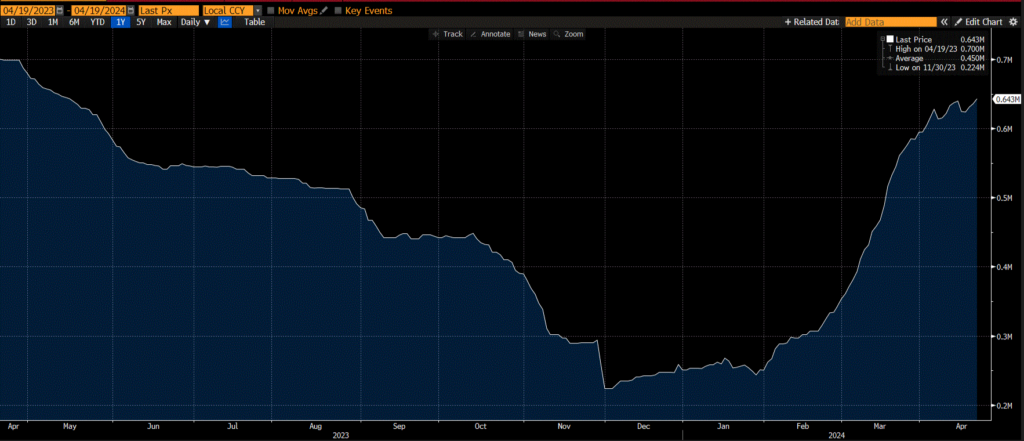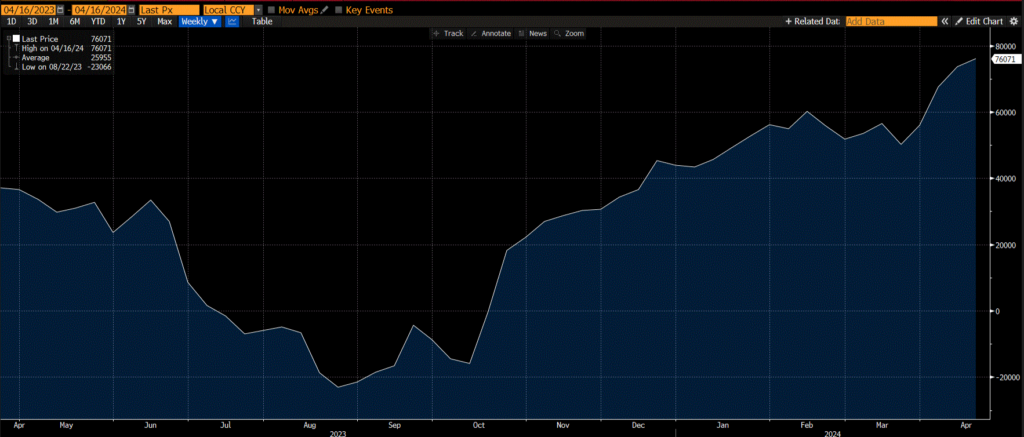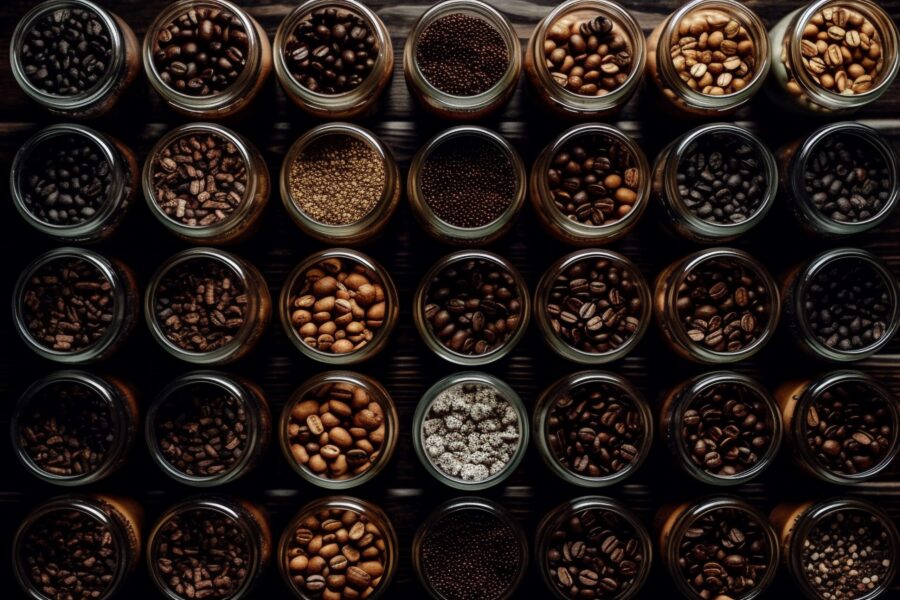The astonishing run for cocoa prices has yet to lose steam, with the commodity rising by +21.6% over the month of April, bringing the year-to-date gain to +223.3% as of April 19th. I wrote a note a little over a month ago about the supply issues in the cocoa industry that have caused the parabolic move in price. The high-level takeaway was that decades of underinvestment – both in the husbandry of existing cocoa trees, as well as a lack of new tree plantings – has led to fragility in the Cote d’Ivoire supply chain, which is responsible for about 40% of global cocoa production. Extreme weather and disease have led to a forecasted cocoa deficit of about 350k-500k tons for this year’s growing season, with expectations that this tightness will continue into next year. The conclusion of my previous note was that because it takes about five years for a new cocoa tree to go from seed to pod, the supply chain fragility won’t be solved overnight and the price action of cocoa in the short-term will therefore be driven by changes to consumer demand.
The first look at demand for cocoa since the massive rise in prices over 2024 arrived last Thursday, and the results were less bearish for the commodity than expected. The National Confectioners Association reported that cocoa grinding, the process from which beans are turned into butter and powder, showed strong increases in global demand over the last quarter. While the report wasn’t outright bullish, as European cocoa grinding declined by -2.2% on a year-over-year basis, the relative resiliency in demand given the enormous price increases shows that the cocoa rally may still have legs. The resiliency in demand may not be surprising given cocoa demand is extremely inelastic, with the short- and long-run estimates being 0.06 and 0.34, respectively. Cocoa producer prices also only account for approximately 10% of the retail price of chocolate, so chocolatiers do have the ability to look to other areas in the supply chain to find savings if they don’t want to pass through the full increase in cocoa costs to their retail consumers.
To provide some context around price inelasticity and demand destruction, the previous high in cocoa prices was $4,500/ton back in 1977, which in inflation-adjusted terms would be equivalent to $23,000/ton in today’s dollars. While this might all seem extremely bullish, there have been some constructive developments as it relates to a narrowing of the short-term supply deficit. The extreme weather from El Niño that has been affecting the 2023-2024 harvesting season appears to be weakening, and the transition to La Niña this summer could bring more temperate climate to improve yields for the main crop for the 2024-2025 season. In addition, while cocoa prices that farmers in West Africa receive are set at a fixed price to provide pricing stability for farmers, both Ghana and Cote d’Ivoire have recently raised farmgate prices by about 50% to deter smuggling. This increase in prices that farmers will receive for their mid-crop will be helpful to invest in fertilizer and pesticides for aging trees, which again could help to boost yields for next season. On the other hand, new regulation from the European Union that comes into place at the end of the year, but will affect beans from this harvest, makes it so that European importers will have to trace cocoa from pod to port and prove that its movement through the supply chain hasn’t contributed to deforestation. Although non-compliant beans could theoretically be sold into Asian or U.S. markets, the European Union is by far the biggest buyer of cocoa produced in Cote d’Ivoire, so I would imagine that land available for additional plantings could be constrained as a result.
The lack of origin diversification and supply chain risk have kept me bullish that longer-term prices for cocoa are likely to settle higher than they have been in the past, though I do acknowledge the current nose-bleed levels make it vulnerable to a pullback. A similar situation with lack of production diversification and supply chain fragility has also started to arise in another agricultural commodity, as Arabica coffee prices have increased by +27.8% over the month of April (to the 19th). While prices for Arabica beans were pretty much flat for the first quarter of the year, as it was anticipated that Brazilian production would remain high, sporadic weather from El Niño has led to heavy rains in Brazil. A region which accounts for about 30% of Brazil’s Arabica production has received about three times the historic average in rainfall, with the excess moisture fearing to have damaged crops and potentially the yield for this year’s harvest. Not only have prices for Arabica beans (generally used in higher-end coffee) increased in April, but Robusta futures (generally used for instant coffee) have also been increasing throughout the year due to a drought in Vietnam, with front-month Robusta futures contracts up +44.2% on the year. Vietnam is the largest producer of Robusta beans and at the end of March, Vietnam’s agricultural department projected that coffee production in the region could drop by -20% for the current crop year. The sporadic weather patterns from El Niño are putting a dent in the International Coffee Organization forecasts from late 2023 that coffee supply would rise by +5.8%, creating an excess surplus for the year of one million bags. We’re seeing the futures curve shift into slight backwardation as a result, as front-month prices have increased more than the rest of the curve.

Unlike in the cocoa market, coffee inventories have rebounded late in the first quarter of 2024, which could help to reduce some of the upward pressure on prices should a more material imbalance develop. However, momentum and trend models are turning in favour of Arabica beans, and we’ve also seen speculative traders boost their long positioning in coffee on the prospect of lower yields in Brazilian Arabica production. This is different than the squeeze we’ve seen in cocoa, as speculative traders are reducing their net positioning as prices and volatility increase. .


In short, it’s too early to say that coffee is the next cocoa, as the fundamental picture doesn’t look nearly as dire. However, it does provide rationale as to how a lack of origin diversification in agricultural crops can contribute to price volatility, especially with extreme weather patterns. We continue to recommend investors obtain commodity exposure in their portfolios, as we don’t foresee what has developed in the cocoa and coffee markets as one-off events given the underinvestment issues that persist throughout the commodity complex. Even when a market may seem in balance from a supply and demand perspective, supply shocks can give rise to portfolio alpha at uncertain times, providing true diversification benefits that portfolios require when the correlation between stocks and bonds is positive.
Happy investing!
Scott Smith
Chief Investment Officer
DISCLAIMER:
This blog and its contents are for informational purposes only. Information relating to investment approaches or individual investments should not be construed as advice or endorsement. Any views expressed in this blog were prepared based upon the information available at the time and are subject to change. All information is subject to possible correction. In no event shall Viewpoint Investment Partners Corporation be liable for any damages arising out of, or in any way connected with, the use or inability to use this blog appropriately.

